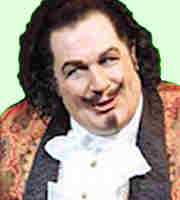Copyright

Michael Ball as Count Fosco in
the 2005 Broadway production (you know exactly what cards your opponent holds) is an improved version of one of my earliest, which first appeared in Original Card Games (1977) under the name Jacko. The improvement consists in eliminating lots of frivolously irrelevant scoring details and simplifying the rules so as to concentrate on the basic point of the game. I couldn't call it Jacko any more, as the Jack is not worth 0 (that honour falls to the Queen), so decided instead to name it after a count. And given that (a) I have already used Dracula, and (b) Monte Cristo is too long (like most of Dumas' works), and (c) I have recently read nearly all the novels of Wilkie Collins, I decided to plump for the villainous character of The Woman in White. (Portrayed, right, by Michael Ball.)
The basic game is for two, but see below for a four-player partnership version.
- Cards
- Deal 26 cards each from a 52-card pack - or, more conveniently, cut the pack exactly into two and take half each. Sort your cards face up into their suits, then construct a playing hand consisting of all the spades and hearts you hold, and stack the other two suits face down.
- Object and general idea
- The object is to win cards, especially later in the game rather than earlier. Play consists of a number of separate events called 'counts', during which you each in turn play a card face up to the table and announce the numerical total of all cards so far played. The count may not exceed 21, and whoever plays the last card wins all the cards played to it. You must always play a card if you can do so without busting (bringing the count over 21).
- Play
- Whoever holds the majority of spades starts by leading one of them to the first count and announcing its value;
the other then plays a spade and announces the total count of the two cards played; and so on, each in turn playing one
card face up to the table. When you have played out all your spades, replenish your hand by adding all your clubs, and
when you have played all your hearts complete it by adding all your diamonds. (This is more manageable than trying to
start with a hand of 26 cards!).
For counting purposes, numerals Ace to Ten count at face value (1 to 10) and Queen counts 0. Jacks and Kings have special
functions thus:
A Jack counts exactly the same as the previous card played, or acts as a King if preceded by one.
If led to a count it counts 0, since there was no previous card. (So "Jacko" rides again!)
A King increases the count in any way previously agreed on by the players.
- It doubles the current count (so may not be played if the count is more than 10). Or:
- It raises the count to the next multiple of five (i.e. 5, 10, 15, 20). Or:
- It raises the count to the next higher square number (1, 4, 9 or 16). Or:
- It raises the count to the next higher prime number (2, 3, 5, 7, 11, 13, 17, 19). Or:
- It counts the same as the card led to the current count (or zero if led itself).
- Score
- At end of play, you each score 1 point for each spade you captured in excess of six, and similarly 2 for each heart, 3 for each club, and 4 for each diamond. Thus the highest possible score is 70, for winning all 52 cards, i.e. 7 x (1+2+3+4).
- Game
- Play up to any agreed target, such as 31, or for any agreed number of deals, such as three.
- Optional extras
- You might want to add two or four Jokers. A Joker adds one-half to the count (e.g. if the count is 10 and you play a Joker, it becomes 10½). Or invent another rule for it, like any of the options suggested above for a King Queen = 0 is a very powerful card. You may prefer to avoid having any card count zero, and completely overhaul the functions of Jack, Queen and King, following any of the suggestions made above for a King.
- Fosco for four
- As above, but: Each two players sitting opposite each other are partners. Deal 13 cards per person and arrange your hand in order spades, hearts, clubs, diamonds. You must always play from the earliest of these suits that you still hold, even if it means not following suit. Each pair scores as a partnership, not as individuals.